


JOHANN WOLFGANG GOETHE 1749 -
xxxxxAs we have seen (1774 G3a), the German writer Wolfgang von Goethe produced some outstanding poems, novels and drama within both the romantic and classical movements. Particularly notable were his The Sorrows of Young Werther, and dramas such as Egmont and Torquato Tasso. His later period, from 1805 onwards, saw the publication of his Wilhelm Meister Travels, a wealth of outstanding lyrics -
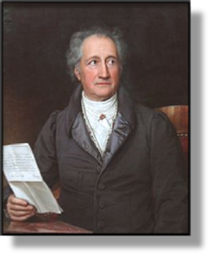 xxxxxAs we have seen (1774 G3a), the German intellectual giant Wolfgang von Goethe produced a vast number of poems, ballads, novels and dramas. His two early works, Goetz of Berlichningen of 1773 and The Sorrows of Young Werther of 1774, marked the beginning of the romantic movement known as Sturm und Drang. However, after a visit to Italy in 1778, he adopted the classical restraints imposed on literature, producing dramas like Iphigenia in Tauris, Egmont and Torquato Tasso. He often worked in collaboration with the German writer Johann Gottfried Herder, and in 1794 began a close friendship with the dramatist Friedrich von Schiller. To this period belong his Roman Elegies and the start of his Wilhelm Meister novels. But Goethe was a man whose interests went well beyond literature. He wrote a great deal on scientific subjects, including osteology, biology and optics.
xxxxxAs we have seen (1774 G3a), the German intellectual giant Wolfgang von Goethe produced a vast number of poems, ballads, novels and dramas. His two early works, Goetz of Berlichningen of 1773 and The Sorrows of Young Werther of 1774, marked the beginning of the romantic movement known as Sturm und Drang. However, after a visit to Italy in 1778, he adopted the classical restraints imposed on literature, producing dramas like Iphigenia in Tauris, Egmont and Torquato Tasso. He often worked in collaboration with the German writer Johann Gottfried Herder, and in 1794 began a close friendship with the dramatist Friedrich von Schiller. To this period belong his Roman Elegies and the start of his Wilhelm Meister novels. But Goethe was a man whose interests went well beyond literature. He wrote a great deal on scientific subjects, including osteology, biology and optics.
xxxxxThis later period, 1805 until his death at Weimar in 1832, was as productive, if not more so, than his output in the 18th century. Apart from his masterpiece Faust, his writing in this period produced a number of notable works, including the novels Elective Affinities and Wilhelm Meister’s Travels, his own Journey to Italy, published in 1816, and his collection of pseudo-
xxxxxFaust, of course, is the work by which Goethe will be for ever remembered. The first part, completed in 1808 was romantic in theme and treatment, and the second part, finished in 1831, was classical in form and spirit -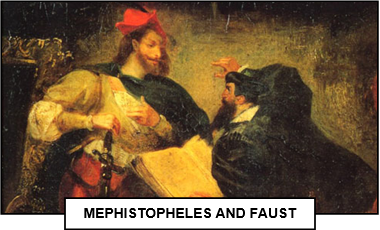 nd experience, was long in the making, written intermittently over a period of more than fifty years. It was not, by any means, therefore, a simple re-
nd experience, was long in the making, written intermittently over a period of more than fifty years. It was not, by any means, therefore, a simple re-
xxxxxIn attempting to assemble in one work this outpouring of his heart and mind, Goethe called Faust a tragedy, but it is full of comic as well as dramatic episodes, features pathos and satire, and has a wealth of poetry in a wide range of verse form. Faust himself, seen as the hero much of the time, is spared a tragic ending -
xxxxxMany writers in the 19th and 20th centuries wrote on the theme of Faust, but none achieved Goethe’s standard or success. In the music world the French composer Hector Berlioz produced a dramatic cantata The Damnation of Faust in 1846, both Franz Liszt and Robert Schumann composed work around the same subject, and the opera Faust, by the Frenchman Charles Gounod, was given its first performance in Paris in 1859. This proved highly successful, but was only based on the first part of Goethe’s work. In his own time, numerous songs and poems were put to music by composers such as Amadeus Wolfgang Mozart and Franz Schubert. It is estimated that by 1912 there were over 2,600 musical compositions based on works by Goethe!
 xxxxxGoethe was a literary colossus, and he gained a worldwide reputation for the quality and width of his writings. A man who possessed an infinite understanding of human needs and aspirations, he wrote of man’s struggle for personal identity, and the fulfillment of his talent -
xxxxxGoethe was a literary colossus, and he gained a worldwide reputation for the quality and width of his writings. A man who possessed an infinite understanding of human needs and aspirations, he wrote of man’s struggle for personal identity, and the fulfillment of his talent -
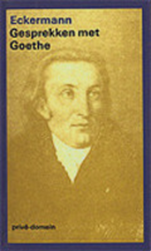 xxxxxGoethe was also an accomplished literary critic, translator and theatre director, but his interest and achievement stretched far beyond the realm of letters. He regarded the entire range of human knowledge as his rightful domain. From his youth he showed an immense interest in art and architecture -
xxxxxGoethe was also an accomplished literary critic, translator and theatre director, but his interest and achievement stretched far beyond the realm of letters. He regarded the entire range of human knowledge as his rightful domain. From his youth he showed an immense interest in art and architecture -
xxxxxGoethe’s life must be seen against a background of rebellion and conflict stretching from the Seven Years’ War to the French revolution of 1830. As we have seen, in 1792 he was a witness to the French Revolutionary Wars, and in 1806 he was himself caught up in Napoleon’s invasion of the German states. He wanted freedom from French rule, but he wished for a return to the traditional form of government, that maintained by petty princes. He regarded this as an orderly and efficient system of political rule. For him greatness was to be found not in collective action, but in the perfection of each individual’s ability, attained by a gradual learning process. In that respect national boundaries were of no consequence to him.
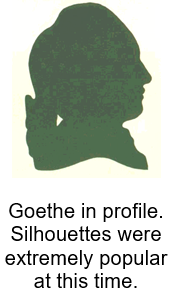
xxxxxApart from his inspirational fellowship with Herder and Schiller, he numbered among his friends and acquaintances a vast number of people. The young Felix Mendelssohn, for example, whom he met at Weimar in 1821, dedicated one of his piano quartets to him four years later; the Scottish social historian Thomas Carlyle translated his Wilhelm Meister’s Apprenticeship in 1824; and among his artist friends he particularly valued the friendship of Johann Tischbein and Angela Kauffmann, the “poetess of the brush” whom he met in Rome and called “the inestimable lady”. He knew the philosophers Friedrich Schelling and Georg Hegel, admired the English poet Lord Byron, and along with the Austrian statesman Klemens Metternich, prided himself in being a “good European”. And, of course, he owed much to his patron, Charles Augustus, duke of Saxony-
xxxxxGoethe died in March 1832 at the age of 82. The story goes that he died writing because, just before his death, he traced out with his finger a large letter “W” on the blanket covering his knees -
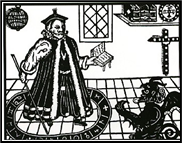 xxxxxIncidentally, the original Faust was a figure of legend, an astrologer and alchemist of the Middle Ages who sold his soul to the devil in order to gain power and go in search of forbidden knowledge. He appeared as the main character in a collection of anonymous tales entitled Faustbuch in 1587. This story inspired the dramatist Christopher Marlow to write The Tragicall History of Doctor Faustus in 1604, but he turned it into a serious battle between good and evil in which Faust receives his just deserts -
xxxxxIncidentally, the original Faust was a figure of legend, an astrologer and alchemist of the Middle Ages who sold his soul to the devil in order to gain power and go in search of forbidden knowledge. He appeared as the main character in a collection of anonymous tales entitled Faustbuch in 1587. This story inspired the dramatist Christopher Marlow to write The Tragicall History of Doctor Faustus in 1604, but he turned it into a serious battle between good and evil in which Faust receives his just deserts -
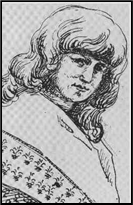
xxxxx…… In 1806, following the Battle of Jena, two French soldiers, keen on plunder, broke into Goethe’s house and threatened him. His long-
xxxxx…… In October 1808 Goethe met Napoleon at Effurt. “Here’s a man!” Napoleon is reported to have said by way of greeting. Apparently they talked about The Sorrows of Werther, a novel which, we are told, Napoleon had read no less than seven times. Four years later Goethe met Beethoven, but this meeting, as we have seen, was far from a success. Neither was impressed with the other!
Acknowledgements
Goethe: by the German painter Joseph Carl Stieler (1781-
Including:
Adelbert von Chamisso

G3c-
xxxxxAnother Faust-
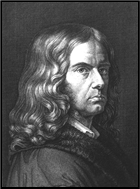 xxxxxAnother Faust-
xxxxxAnother Faust-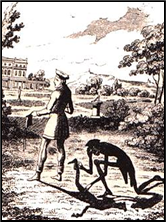 f mind. This supernatural theme caught the imagination of the public and it became a classic of German romantic fiction.
f mind. This supernatural theme caught the imagination of the public and it became a classic of German romantic fiction.
xxxxxAs we have seen earlier, Chamisso was also a talented biologist and collected a large number of plant specimens during a scientific expedition around the world from 1815 to 1818 -


